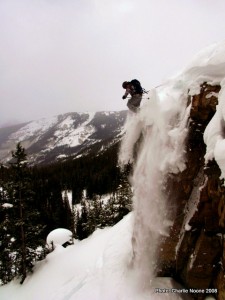
Steve Jay worry free with 30 inches of fresh below him. Scary avalanche conditions can also mean great skiing in the trees below Tagert Hut.
Good judgment comes from experience. Experience comes from bad judgment. – Evan Hardin
Two years ago, the alpine bowls and tributary valleys of Castle Creek conspired with snow and gravity in a failed attempt to assassinate me and 10 of my good friends. I don’t blame them. The laws of physics are ruthless mercenaries, and we made ourselves easy targets by skiing through some catastrophic avalanche paths on the tail end of an enormous snow cycle (40+ inches in three days). My ski partners and I learned a lot that day. We analyzed the trip in and out. Still to this day I wonder about the decisions we made. Mountain guru Lou Dawson even chimed in on the discussion.
We did a lot of things wrong that day, and we did a lot of things right. But mostly we just got lucky. Really f’ing lucky.
Last week I skinned back up Castle Creek with many of the same friends for the first time since the scrape. Last time I was skiing that trail visibility was about 100 meters. On this trip, however, clear, sunny weather opened up visibility to all of the starting zones that nearly ended us. We skied one at a time across the path where, two years ago, I fell into a bottomless willow well with a heavy pack on. I was lucky that one of my ski partners skied by and yanked me out 5 minutes before the hugest avalanche I’d ever seen, heard and felt wiped out an entire pond. That white death extended the existing slide path up onto the facing side of the valley, and settled brick-hard because of the water from the pond.
As we stopped in the trees for lunch and a morning PBR, I gazed ahead at another nightmare memory. “Hey Marco,” I said between bites. “Remember that last trip when that powder blast came roaring out of the clouds just as you were skiing into the trees?”
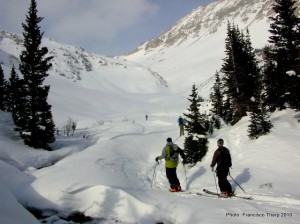
Crossing another big one.
“Yeah,” he said. “I yelled, ‘Avy! Avy!’ and we all started booking it downhill, and it was a good three or four minutes before we could see the person in front of us again.” It was hard to reconcile that reality with the blissfully calm blue bird day we were enjoying.
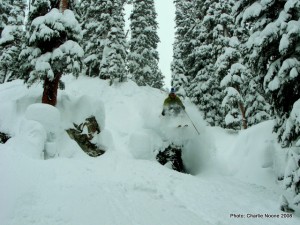
Yet another lap on the seemingly endless pillow lines in 2008. Trees below Tagert Hut.
Once at the huts we settled in for the weekend. We started a fire, filled the melt water pot with (hopefully) clean snow, rigged up some zip-line wine bags, and packed our day packs to go skiing. Just a quick dusk lap before dinner.
Fifteen dudes showed up (some at 2 a.m. thanks to a broken snowmobile clutch). Most of us are friends from high school with some college buddies mixed in, too, and the hut trip has become an annual ritual. It is the only time many of us see each other. That night we reveled and told stories, many of which were about the trip two years ago we had dubbed the “We’re Still Alive Hut Trip of 2008.”
“Oh man, remember skiing over that avalanche debris, and just like, not knowing if someone was under there, and then getting a call on the radio being like, ‘whew! No one’s down there.’”
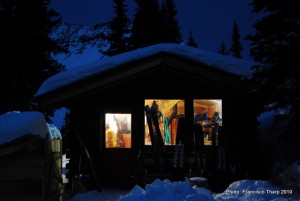
Home sweet home...for a few days anyway.
“Dude, how about night before? The whole hut was shaking from all the slides in Pear Basin. And then that morning debris was across our tracks. Man, we were lucky.”
“So lucky.”
The next day we skied. Our first lap was the best of my season so far: about 1,000 feet of 30 to 35-degree east-facing, waist-deep pow. I felt really safe about our first lap, but as we approached our second I started to feel more uneasy. As we traversed some low-angle gullies that matched the aspect of the pitch we intended to ski, I noticed harder, more slabby snow. Not hollow sounding or feeling, but definitely slabby. The pitch we meant to ski looked full of shark fin rocks that I feared could zipper a slab loose, and a steep convexity added to my worry. As we strapped in to drop in, my intuition flared up. “Guys, I’m not dropping here,” I said. “I just don’t feel good about it.” Trusting that intuition is definitely one piece of learning I carried away from the “We’re Still Alive Trip.”
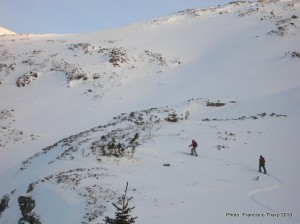
Skinning off into the sunset.
I skied back to the hut with one other partner along our skin track, while the others skied that worrisome pitch. I lost visual contact with them for a couple minutes, and by the time I came around the basin, they were all at the bottom, covered in powder, and putting skins back on. I skied a lower angle pitch down to them and we all skied home together for another great night of fun. No hard feelings, just different risk assessments.
Any close calls I’ve had in the mountains – which, thankfully, have been few and far between – leave me in a sort of hypothetical grieving process. Grief for what could have happened. Guilt for what could have happened. Horror at what could have happened. Occasionally I still beat myself up about our close call in Castle Creek. But returning to that valley with those friends, building our shared narrative of the experience, and putting to use some of the lessons I learned have all been a step toward moving on. I’m sure more will come.
To the laws of physics, those almighty Gods of mountain mayhem.

